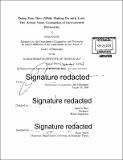Doing your best (while making do with less) : the actual value conception of instrumental rationality
Author(s)
Doody, Ryan (Ryan Dennis)
DownloadFull printable version (8.234Mb)
Alternative title
Actual value conception of instrumental rationality
Other Contributors
Massachusetts Institute of Technology. Department of Linguistics and Philosophy.
Advisor
Agustin Rayo.
Terms of use
Metadata
Show full item recordAbstract
In this thesis, I sketch a decision-theoretic picture of instrumental rationality, which I call the Actual Value Conception: roughly, that you should align your preferences over your options to your best estimates of how the actual values of those options compare. Less roughly: for any options, q and 0, you are instrumentally rational if and only if you prefer q to / when, and only when, your best estimate of the extent to which O's actual value exceeds 's is greater than your best estimate of the extent to which O's actual value exceeds O's, where an option's actual value equals the value you assign to the outcome that would actually result from performing it. In the first chapter, I argue that this picture underlies causal decision theory by showing that, given some assumptions, the two are equivalent, and that the picture unifies and underlies the intuitive arguments offered for Two- Boxing over One-Boxing in the Newcomb Problem. I also show that the picture is incompatible with evidential decision theory. Evidential decision theory sometimes recommends preferring one option to another even though you are certain that the actual value of the latter exceeds the actual value of the former. In the second chapter, I develop a decision theory for agents with incomplete preferences - called Actual Value Decision Theory - that, unlike its more popular competitors, is consistent with, and motivated by, the picture of instrumental rationality sketched in the first chapter. I argue that, in addition to being a generalization of causal decision theory, Actual Value Decision Theory is supported by many of the same considerations. In the final chapter, I consider two powerful arguments against Actual Value Decision Theory - the Most Reason Argument and the Agglomeration Argument - and I argue that, while neither proves to be fatal, they each bring to light some interesting consequences of taking the Actual Value Conception seriously. In particular: that, first, we should reject the idea that instrumental rationality consists in doing what you have the most reason to do; and, second, that sometimes it is rationally permissible to have non-transitive (but not cyclic) instrumental preferences.
Description
Thesis: Ph. D., Massachusetts Institute of Technology, Department of Linguistics and Philosophy, 2016. Cataloged from PDF version of thesis. Includes bibliographical references (pages 137-141).
Date issued
2016Department
Massachusetts Institute of Technology. Department of Linguistics and PhilosophyPublisher
Massachusetts Institute of Technology
Keywords
Linguistics and Philosophy.